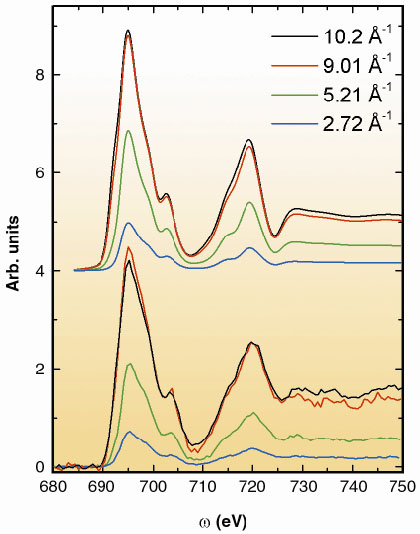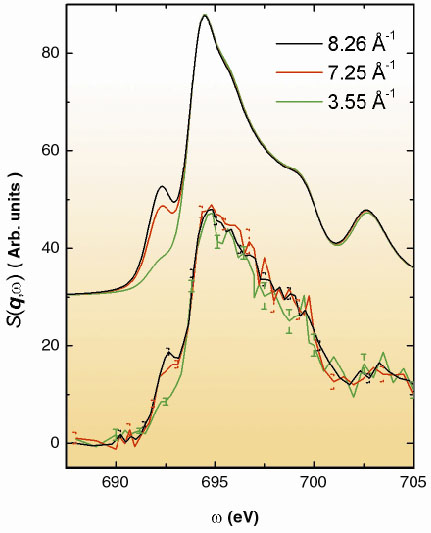- Home
- Users & Science
- Scientific Documentation
- ESRF Highlights
- ESRF Highlights 2001
- Magnetism and Electronic Properties of Solid
- Fluorine K-edge Core Exciton in LiF
Fluorine K-edge Core Exciton in LiF
Non-resonant inelastic X-ray scattering (NRIXS) gives very detailed information about electronic excitations and the underlying electronic structure of materials. The measured inelastic scattering cross-section is proportional to the dynamic structure factor S(q,), which is related to the dielectric function e(q,
) via the fluctuation-dissipation theorem. The dielectric function then directly couples the electronic structure and the macroscopic behaviour of a material, and it is also measurable via the reflectance and refractive index, for example. Therefore, several complementary methods, including electron energy-loss spectroscopy, can be used to determine the dielectric response. However, the uniqueness of the NRIXS technique lies on the fact that both the energy and the momentum transfers (
and q) to the scattering target can be varied, in contrast to optical spectroscopy, for example.
Depending on the momentum and energy transfer values, various elementary excitations can be probed using NRIXS, giving diverse information on the scattering target. In the high-momentum-transfer limit (Compton regime), information about the ground-state momentum density can be obtained. If the dynamic structure factor is written using time-dependent formalism as a Fourier transform of the density-density correlation function, it is easy to see that certain types of collective excitations (plasmons) can be studied as well. Scattering of hard X-rays can also generate single-particle excitations between valence and conduction bands with energy losses of only about 1-10 eV, comparable to optical absorption, where information on the joint density of states can be obtained. However, in the case of NRIXS, hard X-rays can give genuine bulk information even on opaque samples and can excite electrons across an indirect band gap [1].
We have studied NRIXS from relatively deep-lying fluorine 1s core states (often referred to as non-resonant Raman scattering) of LiF. In the case of inner-shell excitations, the transition matrix elements become simpler, and it has been shown that in the low-momentum-transfer limit the scattering cross-section is directly proportional to the absorption coefficient. However, in inelastic scattering the direction of the momentum transfer determines the reference coordinate system instead of the direction of the polarisation, which is the case in X-ray absorption.
 |
Fig. 107: The experimental (lower) and the theoretical NRIXS (upper) spectra of fluorine K-edge in LiF. The various momentum values used are indicated in the figure. |
Figure 107 shows the measured high-resolution NRIXS scattering spectra from LiF measured at beamline ID16 using an eV-resolution backscattering Rowland-circle spectrometer utilising a spherically bent analyser crystal, together with our ab initio calculation. As expected, there is no dramatic momentum transfer dependence in the spectral shape beyond the expected q2 intensity variation. However, when the edge region is measured with better energy resolution (as shown in Figure 108), peculiar intensity dependence for the resolution-limited pre-peak is observed. Our calculation, which takes into account the important electron-hole interaction [2], shows that the observed feature is associated with excitons, typical for a wide-gap insulator like LiF. Furthermore, since our computational scheme is not limited to the dipole approximation, we can associate the pre-peak as an s-type exciton (with an expected q4 intensity dependence).
 |
Fig. 108: The pre-edge region of Figure 107 measured with energy resolution of about 1 eV. The spectra above the pre-edge region are normalised to the same peak value to emphasise the different momentum dependence of the s-type exciton feature at about 692.5 eV. |
With this work we have shown that high resolution NRIXS experimental data together with an ab initio computational scheme can give detailed information about the electronic structure beyond absorption spectroscopy, giving an opportunity to distinguish the various core excitations with different spatial symmetries.
References
[1] W.A. Caliebe, J.A. Soininen, E.L. Shirley, C.-C. Kao and K. Hämäläinen, Phys. Rev. Lett. 84, 3907 (2000).
[2] J.A. Soininen and E.L. Shirley, Phys. Rev. B 64, 165112 (2001)
Principal Publication and Authors
K. Hämäläinen (a), S. Galambosi (a), J.A. Soininen (a), E.L. Shirley (b), J.-P. Rueff (c) and A. Shukla (c), submitted to Phys. Rev. B.
(a) Department of Physical Sciences, University of Helsinki (Finland)
(b) Optical Technology Division, NIST (USA)
(c) ESRF



